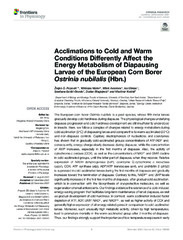Приказ основних података о документу
Acclimations to cold and warm conditions differently affect the energy metabolism of diapausing larvae of the european corn borer ostrinia nubilalis (Hbn.)
| dc.creator | Popović, Željko D. | |
| dc.creator | Maier, Vitezslav | |
| dc.creator | Avramov, Miloš | |
| dc.creator | Uzelac, Iva | |
| dc.creator | Gošić-Dondo, Snežana | |
| dc.creator | Blagojević, Duško | |
| dc.creator | Kostal, Vladimir | |
| dc.date.accessioned | 2022-06-29T12:52:32Z | |
| dc.date.available | 2022-06-29T12:52:32Z | |
| dc.date.issued | 2021 | |
| dc.identifier.issn | 2296-424X | |
| dc.identifier.uri | http://rik.mrizp.rs/handle/123456789/975 | |
| dc.description.abstract | The European corn borer Ostrinia nubilalis is a pest species, whose fifth instar larvae gradually develop cold hardiness during diapause. The physiological changes underlying diapause progression and cold hardiness development are still insufficiently understood in insects. Here, we follow a complex of changes related to energy metabolism during cold acclimation (5°C) of diapausing larvae and compare this to warm-acclimated (22°C) and non-diapause controls. Capillary electrophoresis of nucleotides and coenzymes has shown that in gradually cold-acclimated groups concentrations of ATP/ADP and, consequently, energy charge slowly decrease during diapause, while the concentration of AMP increases, especially in the first months of diapause. Also, the activity of cytochrome c oxidase (COX), as well as the concentrations of NAD+ and GMP, decline in cold-acclimated groups, until the latter part of diapause, when they recover. Relative expression of NADH dehydrogenase (nd1), coenzyme Q-cytochrome c reductase (uqcr), COX, ATP synthase (atp), ADP/ATP translocase (ant), and prohibitin 2 (phb2) is supressed in cold-acclimated larvae during the first months of diapause and gradually increases toward the termination of diapause. Contrary to this, NADP+ and UMP levels significantly increased in the first few months of diapause, after gradual cold acclimation, which is in connection with the biosynthesis of cryoprotective molecules, as well as regeneration of small antioxidants. Our findings evidence the existence of a cold-induced energy-saving program that facilitates long-term maintenance of larval diapause, as well as gradual development of cold hardiness. In contrast, warm acclimation induced faster depletion of ATP, ADP, UMP, NAD+, and NADP+, as well as higher activity of COX and generally higher expression of all energy-related genes in comparison to cold-acclimated larvae. Moreover, such unusually high metabolic activity, driven by high temperatures, lead to premature mortality in the warm-acclimated group after 2 months of diapause. Thus, our findings strongly support the importance of low temperature exposure in early diapause for gradual cold hardiness acquisition, successful maintenance of the resting state and return to active development. Moreover, they demonstrate potentially adverse effects of global climate changes and subsequent increase in winter temperatures on cold-adapted terrestrial organisms in temperate and subpolar regions. | sr |
| dc.language.iso | en | sr |
| dc.publisher | Lausanne : Frontiers media | sr |
| dc.relation | ŽP research stay in the Czech Republic was financed with the post-master research scholarship of the International Visegrad Scholarship Fund (Bratislava, Slovakia), contract no. 51000354. | sr |
| dc.relation | "info:eu-repo/grantAgreement/MESTD/inst-2020/200125/RS//" | sr |
| dc.rights | openAccess | sr |
| dc.rights.uri | https://creativecommons.org/licenses/by/4.0/ | |
| dc.source | Frontiers in physiology | sr |
| dc.subject | diapause | sr |
| dc.subject | energy metabolism | sr |
| dc.subject | ATP | sr |
| dc.subject | NAD+ | sr |
| dc.subject | NADP+ | sr |
| dc.subject | COX | sr |
| dc.subject | gene expression | sr |
| dc.title | Acclimations to cold and warm conditions differently affect the energy metabolism of diapausing larvae of the european corn borer ostrinia nubilalis (Hbn.) | sr |
| dc.type | article | sr |
| dc.rights.license | BY | sr |
| dc.citation.volume | 12 | |
| dc.citation.spage | 768593 | |
| dc.identifier.doi | 10.3389/fphys.2021.768593 | |
| dc.identifier.fulltext | http://rik.mrizp.rs/bitstream/id/4742/bitstream_4742.pdf | |
| dc.type.version | publishedVersion | sr |


